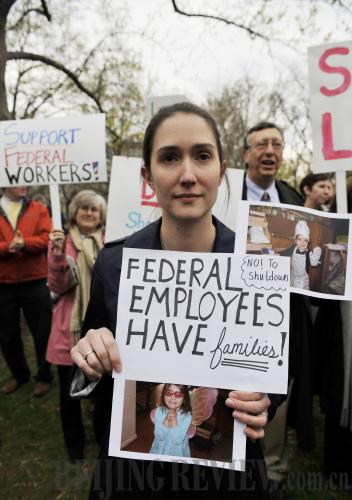|
 |
|
PUBLIC OUTCRY: U.S. diplomats rally outside the State Department in Washington, D.C. on April 8 in support of federal workers against a possible government shutdown triggered by a budget impasse (ZHANG JUN) |

Now that the U.S. Federal Government has reached its legal debt limit of $14.3 trillion, stark choices lie ahead. Current spending growth is unsustainable. Indeed, the Government Accountability Office estimates entitlement spending on Social Security, Medicare and Medicaid alone will amount to more than 20 percent of GDP by 2080, if current policies are unchanged. That level of spending would absorb 100 percent of federal revenues, assuming the federal tax share of GDP increased from its average level of 18 percent to 20 percent.
In the next decade, federal budget deficits could add another $10 trillion to public debt. By 2035, total federal spending could reach 34 percent of GDP, and climb to 42 percent by mid-century. As recently as 2001, federal spending was 18 percent of GDP, but rose to nearly 25 percent in 2009, and has stayed at that level.
The rapid increase in federal spending—from $1.9 trillion in 2001 to $3.8 trillion today—is enlarging the size and scope of government and putting a drag on long-term economic growth. Total government spending at all levels now exceeds 40 percent of GDP. Studies have shown that, once government spending reaches about 20 percent of GDP, additional spending can slow economic growth and significantly decrease future living standards. Because of compounding, a small decline in the growth rate can have a large effect on the level of per-capita real income over time.
Resources shifted into government typically have lower productivity, are wasted, and require higher taxes—now or in the future. Those taxes distort market prices and cause what economists call an "excess burden" or a "deadweight loss"—that is, a net loss of value from limiting mutually beneficial exchanges. The Congressional Budget Office estimates each extra dollar of revenue raised costs the U.S. economy as much as $1.60. Other estimates are even higher. Moreover, as tax rates rise, distortions multiply and deadweight losses mount even faster.
Excessive government spending and high tax rates reduce economic freedom and thus the range of choices open to individuals. When government runs large deficits and adds to the national debt, private investment can be crowded out if interest rates rise. That process has been delayed because China and other foreign lenders have provided the U.S. Government with cheap credit while the U.S. Federal Reserve has artificially lowered interest rates by acquiring massive amounts of Treasury securities. China is now the largest foreign holder of U.S. Treasuries, with an estimated $1.15 trillion invested, while the Federal Reserve holds $1.37 trillion on its balance sheet.
The Federal Reserve's second round of quantitative easing that began earlier this year will have added $600 billion in Treasury securities to the Fed's books by the time the program ends in June. When the Fed buys government debt, it creates bank reserves, expanding the monetary base. Since the onset of the recession in 2008, the Fed has vastly expanded its balance sheet from $907 billion in September 2008 to $2.7 trillion today. In the process, the monetary base has increased from $848 billion in January 2008 to $2.6 trillion today.
|
